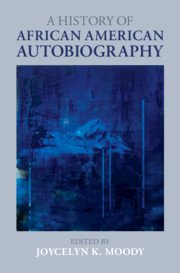33 results
Chapter 15 - Lyrical Mobilities
- from Part IV - Form
-
-
- Book:
- Latinx Literature in Transition, 1848–1992
- Published online:
- 10 April 2025
- Print publication:
- 17 April 2025, pp 260-276
-
- Chapter
- Export citation
41 - After Empire: Postcolonialism and the Essay
- from Part V - The Essay and the Essayistic Today
-
-
- Book:
- The Cambridge History of the British Essay
- Published online:
- 31 October 2024
- Print publication:
- 04 July 2024, pp 619-634
-
- Chapter
- Export citation
27 - History Touches Us Everywhere
- from Queer Genre
-
-
- Book:
- The Cambridge History of Queer American Literature
- Published online:
- 17 May 2024
- Print publication:
- 06 June 2024, pp 470-486
-
- Chapter
- Export citation
13 - Body of Knowledge
- from Part III - Quare Bodies
-
-
- Book:
- The Cambridge Companion to the Black Body in American Literature
- Published online:
- 09 May 2024
- Print publication:
- 16 May 2024, pp 191-203
-
- Chapter
- Export citation
Chapter 7 - Translating Chronic Pain and the Ethics of Reading in the Personal Essay
- from Part II - Developments: Forms
-
-
- Book:
- Literature and Medicine
- Published online:
- 17 January 2024
- Print publication:
- 18 January 2024, pp 120-136
-
- Chapter
- Export citation
14 - African American Literature and Visual Culture
- from Part IV - Critical Approaches
-
-
- Book:
- The Cambridge Companion to Contemporary African American Literature
- Published online:
- 14 December 2023
- Print publication:
- 21 December 2023, pp 239-253
-
- Chapter
- Export citation
Chapter 9 - Life Writing in Comics
- from Part II - Readings
-
-
- Book:
- The Cambridge Companion to Comics
- Published online:
- 17 August 2023
- Print publication:
- 31 August 2023, pp 185-203
-
- Chapter
- Export citation
Introduction
-
-
- Book:
- Decoding Anne Lister
- Published online:
- 29 June 2023
- Print publication:
- 13 July 2023, pp 1-17
-
- Chapter
-
- You have access
- Open access
- HTML
- Export citation

Decoding Anne Lister
- From the Archives to ‘Gentleman Jack'
-
- Published online:
- 29 June 2023
- Print publication:
- 13 July 2023
-
- Book
-
- You have access
- Open access
- Export citation
1 - Diaries, Life Writing and Popular Ruralism
-
- Book:
- Lifescapes
- Published online:
- 20 April 2023
- Print publication:
- 11 May 2023, pp 15-24
-
- Chapter
- Export citation

Lifescapes
- The Experience of Landscape in Britain, 1870–1960
-
- Published online:
- 20 April 2023
- Print publication:
- 11 May 2023
9 - Constellational Form in Gerald Murnane
- from Part II - Authorships
-
-
- Book:
- The Cambridge Companion to the Australian Novel
- Published online:
- 03 March 2023
- Print publication:
- 02 March 2023, pp 148-162
-
- Chapter
- Export citation
Literary Analysis of a Memory Book by a Schoolteacher with HIV in Rural Uganda: Writing about Living with and Dying of HIV
-
- Journal:
- African Studies Review / Volume 66 / Issue 1 / March 2023
- Published online by Cambridge University Press:
- 17 January 2023, pp. 45-73
-
- Article
- Export citation
Scientific Ghostwriting in the Amazon? The Role of Experts in the Lawsuit against Chevron in Ecuador
-
- Journal:
- Comparative Studies in Society and History / Volume 64 / Issue 2 / April 2022
- Published online by Cambridge University Press:
- 01 April 2022, pp. 335-362
-
- Article
-
- You have access
- Open access
- HTML
- Export citation
Chapter 9 - Life-times
- from Part I
-
- Book:
- The Christian Invention of Time
- Published online:
- 13 January 2022
- Print publication:
- 03 February 2022, pp 181-205
-
- Chapter
- Export citation
14 - Life Writing
- from Part II - Prose Genres
-
-
- Book:
- The Cambridge Companion to Prose
- Published online:
- 05 November 2021
- Print publication:
- 18 November 2021, pp 233-246
-
- Chapter
- Export citation
Chapter 13 - Life Writing
- from Part II - Literary Forms
-
-
- Book:
- The Cambridge Companion to British Romanticism and Religion
- Published online:
- 01 October 2021
- Print publication:
- 21 October 2021, pp 217-234
-
- Chapter
- Export citation

A History of African American Autobiography
-
- Published online:
- 30 September 2021
- Print publication:
- 22 July 2021
9 - Transgender and Transgenre Writing
- from Part II - Approaches
-
-
- Book:
- The Cambridge Companion to Twenty-First Century American Fiction
- Published online:
- 02 September 2021
- Print publication:
- 23 September 2021, pp 174-195
-
- Chapter
- Export citation
Chapter 2 - Black Life Writing and Print Culture before 1800
- from Part I - Origins and Histories
-
-
- Book:
- A History of African American Autobiography
- Published online:
- 30 September 2021
- Print publication:
- 22 July 2021, pp 23-38
-
- Chapter
- Export citation

